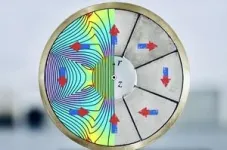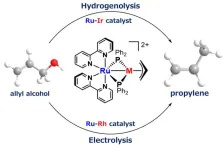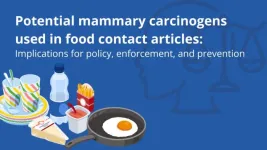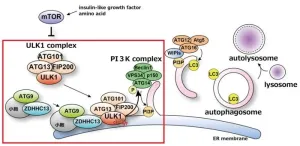(Press-News.org) With strong bactericidal properties, graphene has the potential to become a game changer in the fight against antibiotic-resistant bacteria. So far there have been no efficient ways to control these properties – and thus no way to make use of graphene’s potential in healthcare. Now researchers at Chalmers University of Technology, in Sweden, have solved the problem by using the same technology found in an ordinary fridge magnet. The result of which, is an ultra-thin acupuncture-like surface that can act as a coating on catheters and implants – killing 99.9 percent of all bacteria on a surface.
Healthcare-associated infections are a widespread problem around the world, causing great suffering, high healthcare costs and a heightened risk of increased antibiotic resistance. Most infections occur in connection with the use of various medical technology products such as catheters, hip prostheses, knee prostheses and dental implants, where bacteria are able to enter the body via a foreign surface. At Chalmers University of Technology, researchers have been exploring how graphene, an atomically thin two-dimensional graphite material, can contribute to the fight against antibiotic resistance and infections in healthcare. The research team has previously been able to show how vertically standing graphene flakes prevent bacteria from attaching to the substrate. Instead, the bacteria are cut to pieces on the razor-sharp flakes and die.
“We are developing a graphene-based, ultra-thin, antibacterial material that can be applied to any surface, including biomedical devices, surgical surfaces and implants to exclude bacteria. “Since graphene prevents bacteria from physically attaching to a surface, it has the added advantage that you do not risk increasing antibiotic resistance, unlike with other chemical alternatives, such as antibiotics,” says Ivan Mijakovic, Professor of Systems Biology at Chalmers University of Technology and one of the authors of the recently published study.
Kills 99.99% of bacteria on a surface
However, the researchers have been facing a challenge. Although its bactericidal properties can be demonstrated in the laboratory, the researchers have not yet managed to control the orientation direction of the graphene flakes– and subsequently not been able to apply the material on surfaces used on medical devices used in healthcare. So far, the bactericidal properties of graphene have only been able to be controlled in one specific direction: the flow direction of the manufacturing process. But now the Chalmers researchers have had a promising breakthrough for a practical application in healthcare - and beyond.
“We have managed to find a way to control the effects of graphene practically in several different directions and with a very high level of uniformity of the orientation. This new orientation method makes it possible to integrate graphene nanoplates into medical plastic surfaces and get an antibacterial surface that kills 99.9% of the bacteria that try to attach. This paves the way for significantly greater flexibility when you want to manufacture bacteria-killing medical devices using graphene”, says Roland Kádár, Professor of Rheology at Chalmers University of technology.
Unpreceded efficiency by controlling magnetic fields
By arranging earth magnets in a circular pattern making the magnetic field inside the array arrange in a straight direction, the researchers were able to induce a uniform orientation of the graphene and reach a very high bactericidal effect on surfaces of any shape.
The method, published in Advanced Functional Materials, is called "Halbach array" and means that the magnetic field inside the magnet array is strengthened and uniform while it is weakened on the other side, enabling a strong unidirectional orientation of graphene. The technology is similar to what you would find in a refrigerator magnet.
“This is the first time the Halbach array method has been used to orient graphene in a polymer nanocomposite. Now that we have seen the results, of course we want these graphene plates to get introduced in the healthcare sector so that we can reduce the number of healthcare-related infections, reduce suffering for patients and counteract antibiotic resistance”, says Viney Ghai, researcher in Rheology and Processing of Soft Matter at Chalmers University of Technology.
The new orientation technology shows significant potential in other areas, for example in batteries, supercapacitors, sensors and durable water-resistant packaging materials.
“Given its broad impact across these areas, this method truly opens up new horizons in material alignment, providing a powerful tool for the successful design and customisation of nanostructures that biomimic the intricate architectures found in natural systems,” says Roland Kádár.
Illustration caption: Illustration of how the razor-sharp flakes of graphene line up together on a surface and can kill bacteria without harming healthy human cells. The bactericidal graphene surfaces developed at Chalmers University of Technology may soon be applied in medical devices thanks to a brand-new method using fridge magnet technology to control the bactericidal effects of graphene.
Illustration credit: Yen Sandqvist
Graphic 2 caption: Composite illustration of the new Halbach array magnetic field orientation setup, where the red/blue arrows indicate the magnetization direction of the individual magnets and a numerical simulation showing the magnetic field lines inside the magnet array, where the magnetic field strength reaches 1 Tesla.
Graphic credit: Roland Kadar; numerical simulation using the Comsol Multiphysics software
More about the research:
Read the study: Achieving Long-Range Arbitrary Uniform Alignment of Nanostructures in Magnetic Fields.
The study has been carried out within the framework of the competence center 2D-TECH hosted by Chalmers University of Technology. The center is financed by Vinnova, Chalmers and 19 industrial partners, and constitutes a Swedish hub for research and innovation in 2D material-based technology for applications in industry.
For more information, contact:
Roland Kádár, Professor of Rheology at the Department of Industrial and Materials Science at Chalmers University of Technology
roland.kadar@chalmers.se
+46-31-772 12 56
Viney Ghai, Researcher in Rheology and Processing of Soft Matter at the Department of Industrial and Materials Science at Chalmers University of Technology
ghai@chalmers.se
Ivan Mijakovic, Professor of Systems Biology at the Department of Life Sciences at Chalmers University of Technology
ivan.mijakovic@chalmers.se
Roland Kádár speaks English and Viney Ghai speaks English, Hindi and Punjabi, and they are both available for live and pre-recorded interviews. At Chalmers there are podcast radio studios and film equipment to be used for inquiries about TV, radio or podcasts.
More about the method:
In laboratory experiments, the researchers exposed different bacterial cultures to graphene surfaces whose magnetic fields had been manipulated according to the new method. In order to calculate how effective the method was, the bacterial survival was measured using CFU (colony-forming unit), a tool that measures the number of microorganisms in a bacterial colony. With the help of so-called Scanning Electron Microscopy (SEM), the researchers were also able to scan bacterial colonies in order to visualise and confirm using images the physical disturbance of the graphene on the bacterial cells.
More supporting material - film:
Watch the film on how a tiny layer of graphene flakes becomes a deadly weapon and kills bacteria, stopping infections during procedures such as implant surgery: https://youtu.be/qkTmNKiGTlM
END
Graphene spike mat and fridge magnet technology to fight against antibiotic resistance
2024-09-24
ELSE PRESS RELEASES FROM THIS DATE:
Queen’s University Belfast to launch Figshare-powered repository to share, showcase and manage its research data and theses
2024-09-24
Figshare, a leading provider of institutional repository infrastructure that supports open research, is pleased to announce that Queen’s University Belfast has chosen Figshare as its new repository platform to store, showcase and manage its research data and theses outputs.
Queen’s – a prestigious Russell Group UK university and ranked in the top 250 universities in the world – chose Figshare as its new repository platform owing to a selection of core features and functionality that will support the team in creating proficient ...
Nursing shortages can be deadly
2024-09-24
A new paper in the British Journal of Surgery, published by Oxford University Press, shows that nursing shortages result in longer hospital stays and worse patient outcomes, including higher mortality.
Doctors perform over 300 million surgeries each year worldwide. Observers have expressed concern about the quality of care for adult patients undergoing surgery and the rising cost of avoidable complications, extended hospitalizations, and readmissions. Some 55% of surgical site infections are preventable.
Until now ...
60-second heartbeat recordings offer window into autonomic health after severe brain trauma
2024-09-24
For the over 1 million Americans who survive severe traumatic brain injuries each year, the road to recovery is often long and challenging. Disruption of the autonomic nervous system, which controls involuntary functions like heart rate, is a common yet poorly understood consequence of TBI. While heart rate variability (HRV) is a widely used measure of autonomic function, the standard 5-minute recording can be cumbersome for patients with cognitive and physical impairments.
Now, a team led by researchers at Universidade Federal de Santa Catarina has found ...
Psychedelic drug psilocybin changes brain connectivity to treat body dysmorphic disorder
2024-09-24
New York, NY - Body dysmorphic disorder (BDD) is a debilitating mental illness characterized by an obsessive preoccupation with perceived flaws in one's physical appearance. Patients with BDD often have distorted self-image, intrusive thoughts, and compulsive behaviors that significantly impair daily functioning and quality of life. Current therapies have limited efficacy, leaving many sufferers without relief.
A new study led by researchers at Columbia University and published in Psychedelics (Genomic Press, New York, USA) provides hope by revealing how the psychedelic drug ...
Google trends reveals surge in ADHD medication searches during COVID-19 pandemic
2024-09-24
In a groundbreaking study published in Brain Medicine (Genomic Press), UCI researchers have uncovered a striking correlation between internet searches for ADHD medications and actual prescription rates during the COVID-19 pandemic. This finding opens up new possibilities for using online search data to predict and prevent prescription drug shortages.
The study, led by Dr. Steven Grieco from the University of California, Irvine, analyzed Google Trends data spanning 20 years, with a particular focus on the period following the onset of the COVID-19 pandemic in January 2020. The researchers found a significant surge in searches for ADHD medications during ...
Multiple sclerosis symptoms at onset linked to long-term disability
2024-09-24
In a significant advance for multiple sclerosis (MS) research, a new study has uncovered a potential link between certain initial symptoms and long-term disability outcomes. The research, published in the latest issue of Brain Medicine (Genomic Press, New York), could have far-reaching implications for early intervention strategies and treatment decisions in MS care.
Led by Dr. João Pedro F. Gonçalves from the Federal University of Bahia, Brazil, the study analyzed data from 195 MS patients, focusing ...
New catalyst developed for sustainable propylene production from biomass
2024-09-24
Achieving carbon neutrality requires the effective use of renewable biomass. In the production of biodiesel, for instance, glycerol is generated as a major byproduct. Researchers at Osaka Metropolitan University have developed a new catalyst that efficiently converts a derivative of glycerol into bio-based propylene, contributing to sustainable chemical production.
Propylene is typically produced from petroleum and is widely used in the manufacture of plastics, such as automobile bumpers and food containers. The research team, led by Associate Professor Shin Takemoto and Professor Hiroyuki Matsuzaka from the Graduate School of Science, developed a catalyst that ...
Nearly 200 potential mammary carcinogens found in food contact materials: new study highlights regulatory shortcomings
2024-09-24
About this study: Research identifies nearly 200 potential breast carcinogens in food contact materials, including plastics and paper, highlighting widespread exposure despite existing regulation. The findings underscore an urgent need for stronger preventative measures to reduce these chemicals in everyday products.
Researchers from the Food Packaging Forum identify and discuss nearly 200 potential breast carcinogens that have been detected in food contact materials (FCMs) on the market. ...
Mechanism behind autophagy trigger unveiled
2024-09-24
Osaka, Japan – An international research team led by Osaka University has identified a new mechanism crucial for the initiation of autophagy, a self-degradation process cells use to eliminate unneeded or damaged components. In recent years, autophagy has also been recognized for its roles in aging and lifespan regulation.
During autophagy, intracellular molecules and structures are sequestered within a membrane-bound structure known as an autophagosome, which is subsequently degraded in lysosomes. It is well-established that the formation of autophagosomes ...
Study: Good nutrition boosts honey bee resilience against pesticides, viruses
2024-09-24
CHAMPAIGN, Ill. — In a new study, researchers at the University of Illinois Urbana-Champaign tackled a thorny problem: How do nutritional stress, viral infections and exposure to pesticides together influence honey bee survival? By looking at all three stressors together, the scientists found that good nutrition enhances honey bee resilience against the other threats.
Their findings are detailed in the journal Science of the Total Environment.
“Multiple stressors are often bad for survival,” said graduate student Edward Hsieh, who led the research ...








